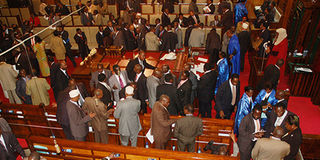Bill on running of counties ready

New law proposes layered structure with governor at the top and ward official at the bottom. Photo/FILE
County governments will have a layered administrative structure if a Bill ready for introduction in Parliament is passed without amendments.
The County Governments Bill, 2012, outlines the structures of governance for each of the 47 counties established by the Constitution, giving Kenyans a glimpse at how devolution will work.
The Bill, published in the Kenya Gazette on January 18, is now ripe for the legislative table following Wednesday's expiry of the 14-day window after which a Bill can be introduced in Parliament, as prescribed in the Standing Orders (House rules).
At the top is the governor and his executive committee (the equivalent of the Cabinet), plus the County Public Service Board. These will form the Executive arm of the county.
Then there is the County Assembly, which will have to get representatives from all the wards in the counties.
This, like the National Assembly, will have the powers to make laws, but the jurisdiction will only be on laws to govern the running of the county.
The governor will have the ultimate power to assent to all Bills approved in the County Assembly.
And then there will be a sub-county administrator, who will be the governor’s eyes and ears at the grassroots.
The sub-county administrator will be in charge of constituencies, a cluster of constituencies or a cluster of wards depending on how each of the counties decides on the size of a sub-county. The Bill contemplates more than one such administrator.
The sub-county boss will be assisted by a ward administrator.
The Bill puts a cap on the number of wards across all the 47 counties to 1,450. This is a clear indication that the current wards will have to be merged.
For the next General Election expected either late this year or early next year, the Bill prescribes that the Independent Electoral and Boundaries Commission should at least set up a minimum of 15 wards per county.
After the polls the IEBC will be free to raise the number of wards in a county to a minimum of 25, provided the delimitation is done at least 12 months before an election.
The IEBC is also obligated to pick the venue where each County Assembly will hold its meetings.
At that meeting, the Chief Justice will have to dispatch judges to swear in the members of the County Assembly, and their Speaker, once they elect him.
For the staff to work in the counties, the new Bill creates a County Public Service Board, which will oversee the hiring, promotion, firing and disciplining of employees.
Public service
If the draft law is passed without amendments, public servants on government payroll will automatically answer to the Board at the county level, only that their pay will come from the national government.
“Each county shall, in accordance with Article 235 of the Constitution, have its own public service to be known as County Public Service,” reads a clause in the Bill.
This will be headed by a county secretary.
The Bill also prescribes that all county governments should come up with their own development plans and directs that the money disbursed for projects shall strictly adhere to the plans.




